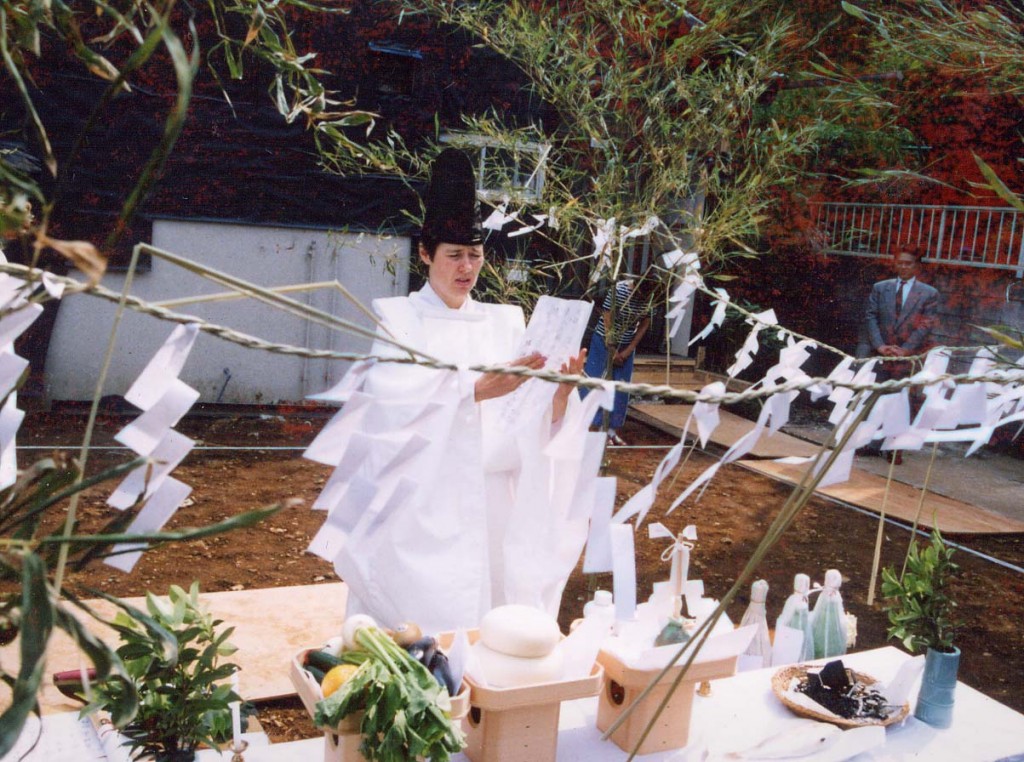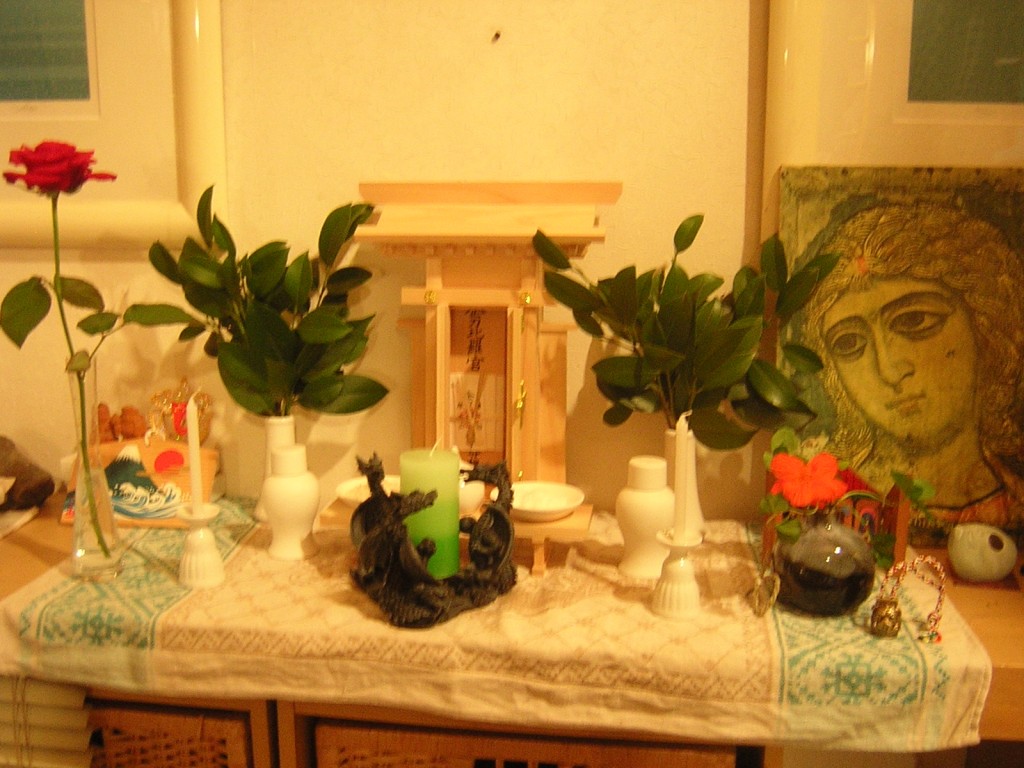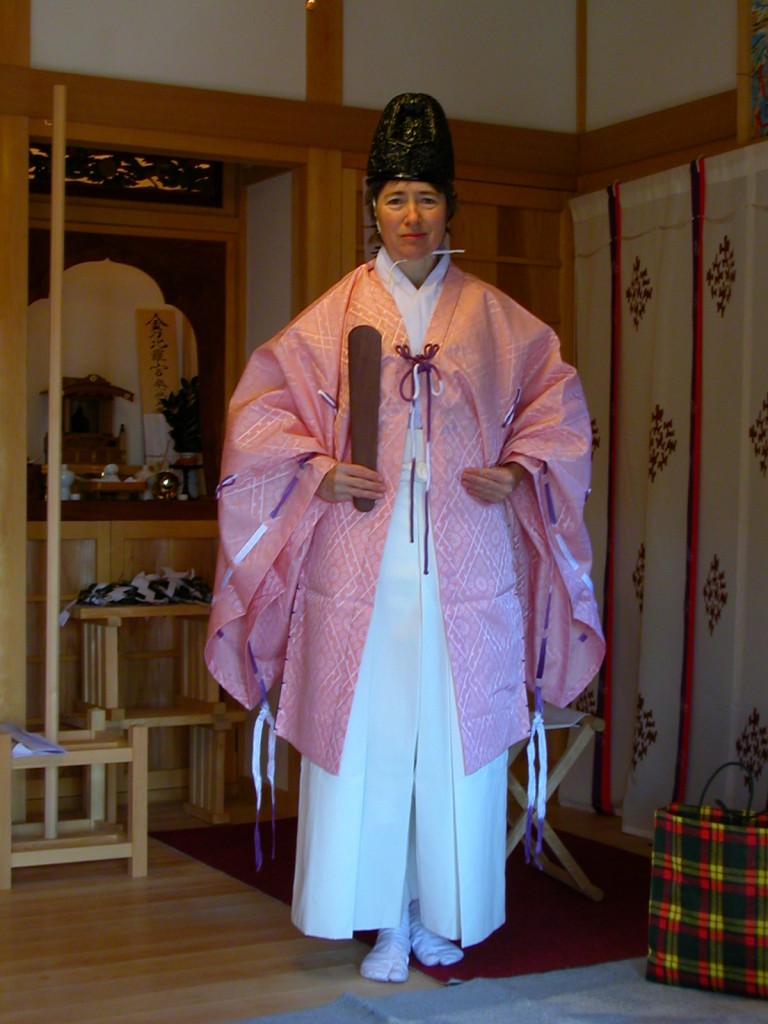
Conducting a 'jichinsai' (land-pacifying) ceremony before the construction of a new building
5) How is Shinto manifest in your daily life now?
I think the more a person can be aware of the divine, the happier he or she will be and the more meaningful his or her life. I have my kamidana in the room where I work, and whenever I look at it, I let go of all my anger or fears. When I am outside, too, the mountains around me are all like friends witnessing my life. When you see the world this way, it is a much happier place and it has a longer perspective than a single human life. The purification prayers and rituals have such refreshing imagery. Whenever I feel troubled, say I’ve had a nightmare, I can summon the great power of nature and feel secure in this world again. My husband does not believe in gods or spirits outside of living beings, but he has also learned the Great Prayer of Purification (Ohharae no Kotoba) and appreciates its healing powers. A person can be agnostic or atheist and still derive a lot of benefit from Shinto. There is joy in maintaining cultural traditions and the wisdom of the elders and in interacting with others on a meaningful level in the community.

Pat Ormsby's altar, complete with Russian Orthodox picture
6) What do you think of the idea that Shinto should be only for Japanese people?
When I first came to Japan, I thought Shinto was only for the Japanese. Foreigners have this impression. I have never heard the Japanese say this, though. Maybe some of them think it, but they never say it. I cannot imagine a group of humans anywhere without a small percentage of them being xenophobic. The only objections to foreign participation I have encountered have been from Japanese who do not like Shinto for some reason. A few Buddhist sects such as Nichiren denounce it, and there are bad memories from World War II.
Each time I go to a new shrine to participate in its public ceremonies, I get some nervous looks from the staff, but when I demonstrate knowledge of the protocol, they are invariably happy. Just a week ago, due to a misunderstanding, I wound up participating (not as a priestess) in a ceremony heavily attended by conservatives. When we inquired at the reception, my husband and I discovered we had not been invited, but the staff insisted we participate anyway. They are surprisingly inclusive. You recall the controversy of Yasukuni Shrine is not its exclusivity, but rather its inclusion of persons designated as Class A war criminals and also some foreigners who died for Japan, whose souls arguably might not want to be there.
Shinto is a set of traditions of which Japan is very proud. When a foreigner shows sincere interest, they take it as a compliment and proof that there really is something special about Shinto. “When in Rome, do like the Romans,” so when in Japan, why not observe Shinto? But it goes beyond that, of course. This is a method of bringing divine inspiration into your life and can be applied wherever you happen to be. The prayers are in Japanese, though, so it takes a commitment to Japan really to practice it, unlike more cosmopolitan religions like Buddhism.
7) How would you like to see Shinto develop in future?
Shinto has got to appeal more strongly to younger Japanese. There is too much materialism now and the young are really going to be in trouble if they fail to find their roots in something beyond the pleasures that money can buy or energy-intensive technology can provide. I think foreigners understand this much better than young Japanese. This is why foreigners in Japan are starting to turn to Shinto. It helps you grow roots here. It helps you understand the heart of Japan.
I like Shinto as it is. There is a lot one can do without taking steps to join the priesthood, which conservative relatives at home are apt to oppose. There are non-shrine forms of Shinto which are less formally organized and more highly participatory, such as Shugendo, which has strong Buddhist influence but emphasizes understanding nature. I participate in Fuji-kyo, which is a folk religion centered around Mt. Fuji, where I live, with more elements of Shinto than Shugendo has. In Shrine Shinto, the knowledge is codified and preserved, but in folk Shinto it is alive and moving. The former involves more strict discipline and a remembrance of how things once were, and this is very important as we face a future in which old knowledge will once again play a crucial role in life. This is why I practice both forms of Shinto.

Pat at the shrine where she trained and practises, Asakawa Konpira
For Part One of this interview, see the previous post below this.

That is an interesting interview; thank you for posting it.
Her comments on the inclusiveness of Shinto certainly echo my experience; I’ve never encountered any reluctance that hasn’t been dispelled by a demonstration of the ability to communicate in Japanese. (Many Japanese don’t know the protocol for a shrine visit either, so the priests are used to explaining – in Japanese.)
To Pat Ormsby,
Милая Пэт, как здорово, что я тебя нашла!
Извини, что пишу сюда.
Мы тебя помним и любим!
Напиши мне: gkhorina@gmail.com
Обнимаю, Галина Хорина (жена Игоря Хорина), Ванкувер
I would like to cnvey my appreciation for your generosity for persons that actually need
guidance on this particular area. Your special dedication to passing the solution across appeared
to be amazingly benmeficial and has continuously made guys
and women jut like me to arrive at their desired goals.
Your entire informnative hints and tips can mean a great deal to
me and omewhat more to my office workers. Thanks a ton; from everyonme of us.
Everything is very open with a clear description of
the challenges. It was really informative.Your website is useful.
Many thanks for sharing!